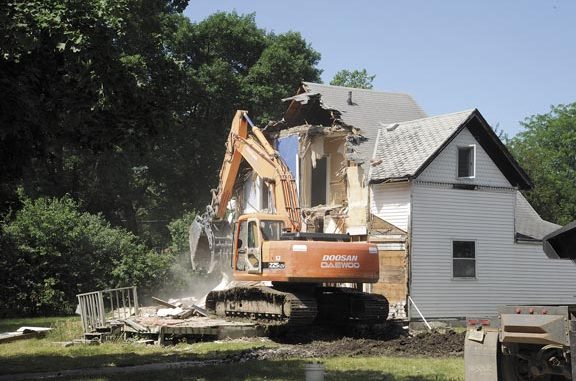

By Seth Schmidt
A house built when families had backyard barns for horses and milk cows bit the dust in Tracy on Thursday.
“It was probably built in the 1880s or ‘90s,” said Dick Kelley, a next-door-neighbor, who purchased the 373 Third St. house, following the death of Allen Haney several years ago. The structure was in poor condition, after sustaining years of drainage and moisture issues. Kelley recalled that during heavy rainfalls, surface run-off would sometimes fill the house’s basement.
“It was full of mold,” said Kelley of the house. One day a young couple pushing a baby stroller asked if they could rent the house, but he declined. “I told them it wasn’t safe to live in.”
Instead, Kelley hired Cooreman Contracting of Tracy to demolish the house, haul away the rubble, and fill-in the basement. A detached garage was left untouched, and will be utilized by Kelley for storage.
• • •
The demolished house might have been the first house to be built on the block.
W. R. Edwards, who published the Tracy Republican and later the Tracy Republican-Trumpet from 1887 to 1910, built the house during Tracy’s pioneer days and lived there for many years. W. R. Edwards’ daughter, Hazel, a 1906 graduate of Tracy High School who died in 1972, was the last family member to live in the dwelling.
Kelley lives one-door further south, in a home built by his parents, Frank and Marjorie (Satre) Kelley in 1961.
Kelley recalls Hazel Edwards telling stories of a small bridge that once crossed Third St. near their front yard. The bridge, heavy enough to carry horse-drawn wagons and buggies, crossed a creek bed.
“After a heavy rain, the water still follows that old creek bed,” Kelley said of the drainage that moves across low-lying city areas from the southwest to northeast.
The Edwards family built the house on low ground, leading to its perennial water problems.
After Hazel Edwards died, Kelley recalled that Nate Taarud brought the house and spent a considerable sum on interior improvements, before turning it into a rental. Nothing was done to correct the basement water problem. Haney brought house later.
The 19th century house originally was considered an above-average house in Tracy. Exterior gingerbread hinted at Victorian elegance. Hardwood trim and floors adorned the rooms. Four stained-glass windows graced an alcove on the south side, with two more to the east. Kelley salvaged the windows, but said there wasn’t much else worth saving. Most of the hardwood trim and doors had been painted over. One room had been used as a dog lavatory.
What does Kelley plan to do with his new vacant lot?
“I’m going to put up a bronze statue of myself, plant some flowers, and turn it into a park that I can give to the city,” he joked.
